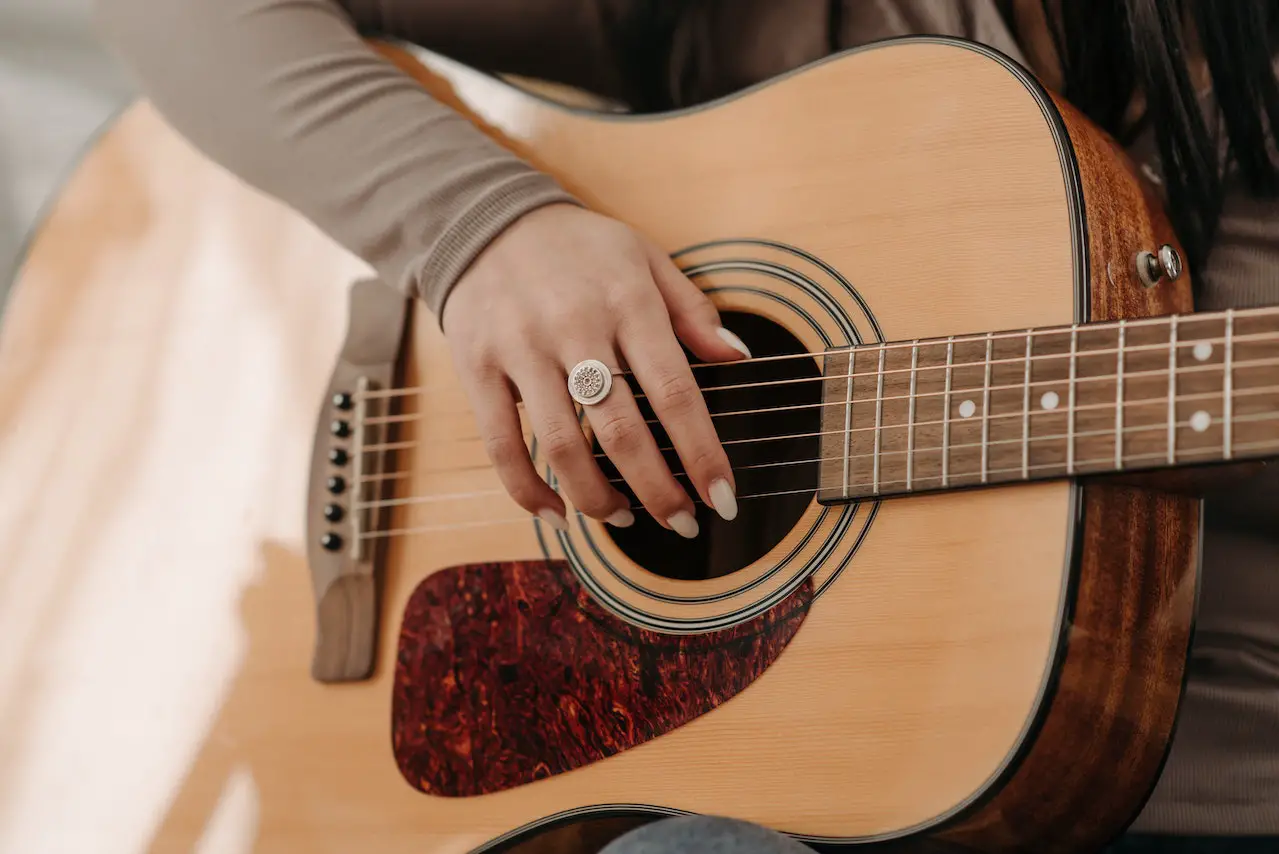5 Factors That Make a Good Guitar Neck
Some of the major factors that have to be considered while choosing a guitar neck are its density or wood material, strength or rigidity, radius, cost and length.
One must make a good neck choice while purchasing a guitar as the neck of a guitar is that which supports the strings and the fretboard. In actual fact, the guitar neck influences the physical appearance, tone, and playability of the instrument.
Maybe you are looking to purchase your first guitar and you don’t want to make mistakes or you have purchased one and you feel it’s not offering you the best services for your money and you are looking to take precautions for your next visit to a pawn shop or guitar center, then check this out.
I will reveal to you in this article what you should look out for in a guitar’s neck and the kind of woods that better resonate and sustain sound for you.
1. Wood Material (Density)
The density of wood plays a part in the tonal characteristics of the guitar neck, thus this is the first thing you would need to pay attention to in your instrument. The shallower the distance between the grains, the less room there will be for the sound waves to go through.
Bright, sharp sounds will be produced by such guitar necks. While a less dense wood will permit more sound to pass, increasing the sustainability of the tone.
Density is necessary for a neck’s resistance to bending, which can cause the strings to temporarily go out of tune. This is why people prefer guitars with neck wood such as; rosewood, mahogany, and maple.
2. Radius
The smaller the radius, the more round the fretboard will feel. Great for playing chordal music, more complex chord voices, and pick-and-finger techniques, especially high on the neck, although they can be very difficult to play more complex musical pieces.
The flatter the fretboard is, the easier it is to play technical or fast things and allows for much smoother speed technique in general. Compared to high-radius boards of the same wood, lower-radius boards typically have more sweet spots and a more natural feel.
3. Rigidity
A guitar’s neck must endure a variety of challenges, including climatic fluctuations, harsh handling, ageing, storage, and more.
The wood that is used to construct guitar necks must be strong enough to survive each of these circumstances. High-quality glues should be used in the joining to prevent tone clarity loss.
Due to the lack of firmness, the neck may warp, leading to longer-lasting issues that, if not fixed, will result in the guitar being irreparably damaged. As a result, you might want to pay attention to how solid or rigid the neck of the guitar you admire is.
4. Cost
Another determining factor to know just how good a guitar neck can be is to judge by the cost. This is not so in all cases but true in most cases. This is because expensive guitars will most likely always be of better quality than cheaper guitars.
The detail in which the guitars are made, the type of materials used and how well the adjustments are made is what increases the quality of a guitar, therefore the price.
5. Length
The playability and feel of a guitar are significantly influenced by the length of the neck. Instead of measuring the length of the neck from one end to the other, “scale length” is used to determine the length. The tone and feel of the guitar are greatly influenced by the scale length.
For the proper pitch and feel, the tension over the string must be higher as the scale length increases. Similar to this, a brief scale length necessitates minimal string tension. So, before making a purchase, you might wish to examine the scale length of a guitar.
Also Read: Guitar Neck Reset: What, Why & When To Do It (With Cost)
5 Best Wood for a Guitar Neck
The neck wood affects the tone of a guitar by impacting the way that the vibrations produced by the strings behave. This is why a lot of guitarists are particular about the choice of wood a guitar neck has before purchase. Different types of wood can be used for guitar necks; maple, mahogany etc.
1. Maple
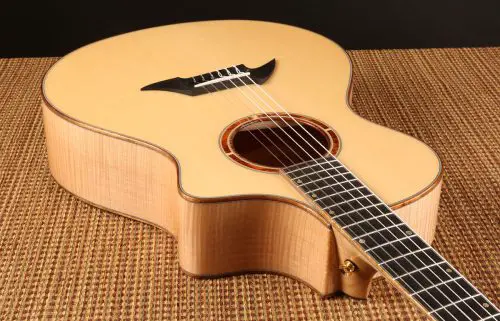
These guitars are designed to produce great volume
This is the standard neck wood for Fender guitars. Strong, firm, and dense, providing excellent sustain and stability. It often has a light golden hue and is renowned for producing tones that are bright and distinct.
This is because it is an extremely hard and solid form of wood with few grains and gaps. Therefore, rather than being absorbed into the wood, the sound is reflected off of it. This indicates that it makes a harsh, compressed sound.
It sounds fairly bright because it favors high frequencies (treble) over low frequencies (bass). They are typically more expensive than guitars with mahogany necks, but still relatively inexpensive.
2. Rosewood
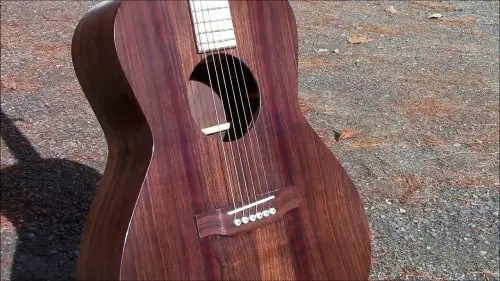
It is a fantastic tone wood wit deep roots in acoustic guitar
Great sustainment and smoother highs are the benefits of a Rosewood neck. More sustainment frequently results in a brighter top end. Although Rosewood mutes the high-frequency overtones, it still creates a strong fundamental with rich mid- and low-mid overtones. Despite their rarity and high price, it provides a rich, powerful, and velvety sound.
3. Wenge
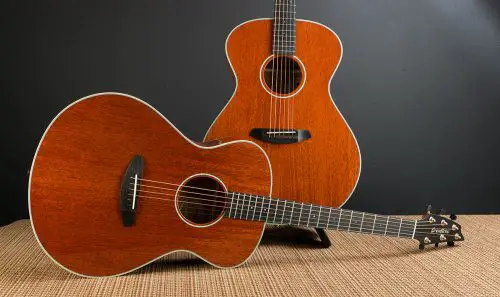
Its a very common wood make electric bass and guitar neck
A rigid, robust black hardwood with chocolate brown markings. Open grain, very hard wood with a rougher feel. With powerful midrange tones and warm lows, this wood makes fantastic bass necks. generally used as neck shafts, but also capable of serving as a rough fretboard.
Wenge has multi-density “stripes” that combine a little more of the mid and low mid overtones, trimming some high overtones like Rosewood while echoing more basic mid and low mid.
4. Mahogany

Its a tone wood that perfectly balances all ranges of sound
Mahogany’s uniform density reduces the likelihood of warping and allows for a very stable neck. The neck is not as dense as maple, but the open pores make the neck a little more responsive than a maple neck.
Generally speaking, Mahogany will absorb a little bit more of the string vibration than Maple will, somewhat compressing the attack and the highs. They are a little cheaper than maple wood.
5. Ash
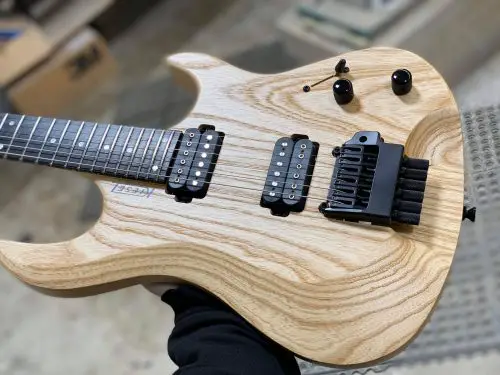
Ash is a great sounding tone wood
A common wood with a bright sound that is renowned for its capacity to hold chords and notes. Ash is one of the most durable and reasonably priced types of wood used to make guitars. It is readily accessible and quite inexpensive, and it is a native of Europe.
Also Read: Is Tung Oil Good on Guitar Wood? (Necks, Fretboards & Body)
FAQs
Q: Does Guitar Neck Radius Affect Playability?
Yes, it does. The playability of a guitar is significantly influenced by the neck profile. Wider-necked guitars are typically more difficult to play.
Especially if your fingers are exceptionally short. On the other side, some guitarists may find it challenging to play with necks that are too narrow. Bottom line: A guitar’s overall playability is significantly influenced by the neck width.
For playing chords, a smaller (more curved) radius is typically seen to be more pleasant; a bigger (less curved) radius is typically thought to be superior for playing single notes and bending.
Fretboard radius is one of the single most important characteristics among the numerous that influence a guitar’s playability and helps to define a guitarist’s style.
Q: Should I oil the neck of my guitar?
Yes, to keep it in top shape for the rest of its lifespan, oil it. Purchase a bottle of mineral oil from the supermarket if your fingerboard is clean and free of debris.
Apply some oil to a folded paper towel and wipe the fingerboard’s face after stuffing all the tuners’ strings into the sound hole. Wipe it on the frets if you want.
Keep in mind that you shouldn’t oil your fretboard frequently, and when you do, you shouldn’t use it much.
If the fretboard and neck are raw, they should be oiled every six months and after each session. Over the years, different instrument fretboard oils have been created using both mineral oil and linseed oil.
Both have advantages and disadvantages, yet they are still effective. Linseed oil-based finishes are my preference because they don’t contain any petroleum.
Q: Which Is Better for sound: Set Neck, Neck-Through, or Bolt-on?
Neck-through designs often provide superior sound. Compared to bolt-on and set-neck guitars, they have a higher tone quality and sustain.
As the name suggests, neck-through guitars are almost exclusively neck. Two wings are attached underneath and on top of the neck, which forms the entire body of the guitar as one continuous piece of wood.
They are thought to have the best overall sustain and resonance of any neck style. The pickup’s entire piece of wood housing will vibrate as a result of the strings, sending sound to your amplifier.
They are frequently preferred by shredders because of their ability to maintain a low action with little movement of the wood.
Because this sort of neck has a center neck-through laminate, which allows guitar builders to bond multiple wood types together, the neck will be less sensitive to circumstances that can cause it to twist and warp (whether it is constructed of three pieces of wood or more). This has been effectively employed to provide amazing neck stability.


